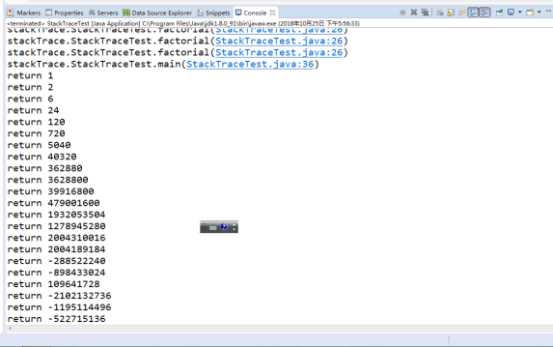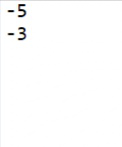实验九 异常、断言与日志
实验时间 2018-10-25
1.知识总结:
异常:在程序的执行过程中所发生的异常事件,它中断指令正常执行。
程序中出现的常见的错误和问题有:
用户输入错误
设备错误
物理限制
代码错误
Java把程序运行时可能遇到的错误分为两类:
1.非致命异常:通过某种修正后程序还能继续执行。这类错误叫异常。
2,致命异常:程序遇到了非常重要的不正常状态不能简单恢复执行。
Java中所有的异常类都直接或间接地继承于Throwable类。除内置异常类外,程序员可自定义异
常类。
Java中的异常类可分为两大类:
- Error
- Exception
Java将派生于Error类或RuntimeException类的所有异
常称为未检查异常,编译器允许不对它们做出异常处
理。
注意:“如果出现
RuntimeException异常,就一定是程序员的问题!
RuntimeException: 运行时异常类
IOException:输入输出异常类
Error很难恢复的严重错误,一般不由程序处理。
声明抛出异常:如果一个方法可能会生成一些异常,但是该方法并不确切知道何对这些异常事件进行处理,此时,这个方法就需声明抛出这些异常。
抛出异常对象通过throw语句来实现。
对于已存在的异常类,抛出该类的异常对象非常容
易,步骤是:
–找到一个合适的异常类;
–创建这个类的一个对象;
–将该对象抛出。
一个方法抛出了异常后,它就不能返回调用者了。
自定义异常类:定义一个派生于Exception的直接
或间接子类。如一个派生于IOExce
程序运行期间,异常发生时,Java运行系统从异常
生成的代码块开始,寻找相应的异常处理代码,并
将异常交给该方法处理,这一过程叫作捕获。
l 某个异常发生时,若程序没有在任何地方进行该异
常的捕获,则程序就会终止执行,并在控制台上输
出异常信息。
l 若要捕获一个异常,需要在程序中设置一个
try/catch/ finally块:
–try语句括住可能抛出异常的代码段。
–catch语句指明要捕获的异常及相应的处理代码。
–finally语句指明必须执行的程序块。
catch块是对异常对象进行处理的代码;
断言:是程序的开发和测试阶段用于插入一些代码错误检
测语句的工具。
l 断言(assert)语法如下:
1、assert 条件
或者
2、assert 条件:表达式
这两个形式都会对布尔“条件”进行判断,如果判断结果
为假(false),说明程序已经处于不正确的状态下,系
统则抛出AssertionError,给出警告并且退出。在第二种
形式中,“表达式”会传入AssertionError的构造函数中
并转成一个消息字符
1、实验目的与要求
(1) 掌握java异常处理技术;
(2) 了解断言的用法;
(3) 了解日志的用途;
(4) 掌握程序基础调试技巧;
2、实验内容和步骤
实验1:用命令行与IDE两种环境下编辑调试运行源程序ExceptionDemo1、ExceptionDemo2,结合程序运行结果理解程序,掌握未检查异常和已检查异常的区别。
| //异常示例1 public class ExceptionDemo1 { public static void main(String args[]) { int a = 0; System.out.println(5 / a); } } |
| //异常示例2 import java.io.*;
public class ExceptionDemo2 { public static void main(String args[]) { FileInputStream fis=new FileInputStream("text.txt");//JVM自动生成异常对象 int b; while((b=fis.read())!=-1) { System.out.print(b); } fis.close(); } } |
异常后:
package 异常;//例1
public class ExceptionDemo1 {
public static void main(String args[]) {
int a=0;
if(a==0) {
System.out.println("除数为零!");
}
else {
System.out.println(5 / a);
}
}
}
package 异常;//例2
import java.io.*;
public class ExceptionDemo2 {
public static void main(String args[]) throws Exception
{
FileInputStream fis=new FileInputStream("text.txt");//JVM自动生成异常对象
int b;
while((b=fis.read())!=-1)
{
System.out.print(b);
}
fis.close();
}
}
实验2: 导入以下示例程序,测试程序并进行代码注释。
测试程序1:
l 在elipse IDE中编辑、编译、调试运行教材281页7-1,结合程序运行结果理解程序;
l 在程序中相关代码处添加新知识的注释;
l 掌握Throwable类的堆栈跟踪方法;
package stackTrace;
import java.util.*;
/**
* A program that displays a trace feature of a recursive method call.
* @version 1.01 2004-05-10
* @author Cay Horstmann
*/
public class StackTraceTest
{
/**
* Computes the factorial of a number
* @param n a non-negative integer
* @return n! = 1 * 2 * . . . * n
*/
public static int factorial(int n)
{
System.out.println("factorial(" + n + "):");
Throwable t = new Throwable();
StackTraceElement[] frames = t.getStackTrace();
for (StackTraceElement f : frames)
System.out.println(f);
int r;
if (n <= 1) r = 1;
else r = n * factorial(n - 1);
System.out.println("return " + r);
return r;
}
public static void main(String[] args)
{
Scanner in = new Scanner(System.in);
System.out.print("Enter n: ");
int n = in.nextInt();
factorial(n);
}
}

测试程序2:
l Java语言的异常处理有积极处理方法和消极处理两种方式;
l 下列两个简答程序范例给出了两种异常处理的代码格式。在elipse IDE中编辑、调试运行源程序ExceptionalTest.java,将程序中的text文件更换为身份证号.txt,要求将文件内容读入内容,并在控制台显示;
l 掌握两种异常处理技术的特点。
| //积极处理方式 import java.io.*;
class ExceptionTest { public static void main (string args[]) { try{ FileInputStream fis=new FileInputStream("text.txt"); } catch(FileNotFoundExcption e) { …… } …… } } |
| //消极处理方式
import java.io.*; class ExceptionTest { public static void main (string args[]) throws FileNotFoundExcption { FileInputStream fis=new FileInputStream("text.txt"); } } |
|
|
读入内容后:
package demo;
import java.io.BufferedReader;
import java.io.FileInputStream;
import java.io.FileNotFoundException;
import java.io.IOException;
import java.io.InputStreamReader;
public class ExceptionTest {
public static void main(String[] args) throws IOException {
try {
FileInputStream fis = new FileInputStream("身份证号.txt");
BufferedReader in = new BufferedReader(new InputStreamReader(fis));
String m, n = new String();
while ((m = in.readLine()) != null) {
n += m + "\n ";
}
in.close();
System.out.println(n);
} catch (FileNotFoundException e) {
System.out.println("学生信息文件找不到");
e.printStackTrace();
} catch (IOException e) {
System.out.println("学生信息文件读取错误");
e.printStackTrace();
}
}
}
package demo;
import java.io.BufferedReader;
import java.io.FileInputStream;
import java.io.IOException;
import java.io.InputStreamReader;
public class ExceptionTest {
public static void main(String[] args) throws IOException {
FileInputStream fis = new FileInputStream("身份证号.txt");
BufferedReader in = new BufferedReader(new InputStreamReader(fis));
String m, n = new String();
while ((m = in.readLine()) != null) {
n += m + "\n ";
}
in.close();
System.out.println(n);
}

实验3: 编程练习
注:以下实验课后完成
练习2:
l 编写一个计算器类,可以完成加、减、乘、除的操作;
l 利用计算机类,设计一个小学生100以内数的四则运算练习程序,由计算机随机产生10道加减乘除练习题,学生输入答案,由程序检查答案是否正确,每道题正确计10分,错误不计分,10道题测试结束后给出测试总分;
l 将程序中测试练习题及学生答题结果输出到文件,文件名为test.txt;
l 在以上程序适当位置加入异常捕获代码。
package 异常;
import java.util.Scanner;
public class Demo {
public static void main(String[] args) {
// 用户的答案要从键盘输入,因此需要一个键盘输入流
Scanner in = new Scanner(System.in);
// 定义一个变量用来统计得分
int sum = 0;
for (int i = 0; i < 10; i++) {
// 随机生成两个10以内的随机数作为被除数和除数
int a = (int) Math.round(Math.random() * 100);
int b = (int) Math.round(Math.random() * 100);
System.out.println(a + "/" + b + "=");
// 定义一个整数用来接收用户输入的答案
int c = in.nextInt();
// 判断用户输入的答案是否正确,正确给10分,错误不给分
if (c == a / b) {
sum += 100;
System.out.println("恭喜答案正确");
}
else {
System.out.println("抱歉,答案错误");
}
}
//输出用户的成绩
System.out.println("你的得分为"+sum);
}
}

实验4:断言、日志、程序调试技巧验证实验。
实验程序1:
| //断言程序示例 public class AssertDemo { public static void main(String[] args) { test1(-5); test2(-3); }
private static void test1(int a){ assert a > 0; System.out.println(a); } private static void test2(int a){ assert a > 0 : "something goes wrong here, a cannot be less than 0"; System.out.println(a); } } |
l 在elipse下调试程序AssertDemo,结合程序运行结果理解程序;
l 注释语句test1(-5);后重新运行程序,结合程序运行结果理解程序;
l 掌握断言的使用特点及public class AssertDemo { public static void main(String[] args) { test1(-5); test2(-3);
}
private static void test1(int a){
assert a > 0;
System.out.println(a);
}
private static void test2(int a){
assert a > 0 : "something goes wrong here, a cannot be less than 0";
System.out.println(a);
}
}

实验程序2:
l 用JDK命令调试运行教材298页-300页程序7-2,结合程序运行结果理解程序;
l 并掌握Java日志系统的用途及用法。
package logging;
import java.awt.*;
import java.awt.event.*;
import java.io.*;
import java.util.logging.*;
import javax.swing.*;
/**
* A modification of the image viewer program that logs various events.
* @version 1.03 2015-08-20
* @author Cay Horstmann
*/
public class LoggingImageViewer
{
public static void main(String[] args)
{
if (System.getProperty("java.util.logging.config.class") == null
&& System.getProperty("java.util.logging.config.file") == null)
{
try
{
Logger.getLogger("com.horstmann.corejava").setLevel(Level.ALL);
final int LOG_ROTATION_COUNT = 10;
Handler handler = new FileHandler("%h/LoggingImageViewer.log", 0, LOG_ROTATION_COUNT);
Logger.getLogger("com.horstmann.corejava").addHandler(handler);
}
catch (IOException e)
{
Logger.getLogger("com.horstmann.corejava").log(Level.SEVERE,
"Can't create log file handler", e);
}
}
EventQueue.invokeLater(() ->
{
Handler windowHandler = new WindowHandler();
windowHandler.setLevel(Level.ALL);
Logger.getLogger("com.horstmann.corejava").addHandler(windowHandler);
JFrame frame = new ImageViewerFrame();
frame.setTitle("LoggingImageViewer");
frame.setDefaultCloseOperation(JFrame.EXIT_ON_CLOSE);
Logger.getLogger("com.horstmann.corejava").fine("Showing frame");
frame.setVisible(true);
});
}
}
/**
* The frame that shows the image.
*/
class ImageViewerFrame extends JFrame
{
private static final int DEFAULT_WIDTH = 300;
private static final int DEFAULT_HEIGHT = 400;
private JLabel label;
private static Logger logger = Logger.getLogger("com.horstmann.corejava");
public ImageViewerFrame()
{
logger.entering("ImageViewerFrame", "<init>");
setSize(DEFAULT_WIDTH, DEFAULT_HEIGHT);
// set up menu bar
JMenuBar menuBar = new JMenuBar();
setJMenuBar(menuBar);
JMenu menu = new JMenu("File");
menuBar.add(menu);
JMenuItem openItem = new JMenuItem("Open");
menu.add(openItem);
openItem.addActionListener(new FileOpenListener());
JMenuItem exitItem = new JMenuItem("Exit");
menu.add(exitItem);
exitItem.addActionListener(new ActionListener()
{
public void actionPerformed(ActionEvent event)
{
logger.fine("Exiting.");
System.exit(0);
}
});
// use a label to display the images
label = new JLabel();
add(label);
logger.exiting("ImageViewerFrame", "<init>");
}
private class FileOpenListener implements ActionListener
{
public void actionPerformed(ActionEvent event)
{
logger.entering("ImageViewerFrame.FileOpenListener", "actionPerformed", event);
// set up file chooser
JFileChooser chooser = new JFileChooser();
chooser.setCurrentDirectory(new File("."));
// accept all files ending with .gif
chooser.setFileFilter(new javax.swing.filechooser.FileFilter()
{
public boolean accept(File f)
{
return f.getName().toLowerCase().endsWith(".gif") || f.isDirectory();
}
public String getDescription()
{
return "GIF Images";
} });
// show file chooser dialog
int r = chooser.showOpenDialog(ImageViewerFrame.this);
// if image file accepted, set it as icon of the label
if (r == JFileChooser.APPROVE_OPTION)
{
String name = chooser.getSelectedFile().getPath();
logger.log(Level.FINE, "Reading file {0}", name);
label.setIcon(new ImageIcon(name));
}
else logger.fine("File open dialog canceled.");
logger.exiting("ImageViewerFrame.FileOpenListener", "actionPerformed");
}
}
}
/**
* A handler for displaying log records in a window.
*/
class WindowHandler extends StreamHandler
{
private JFrame frame;
public WindowHandler()
{
frame = new JFrame();
final JTextArea output = new JTextArea();
output.setEditable(false);
frame.setSize(200, 200);
frame.add(new JScrollPane(output));
frame.setFocusableWindowState(false);
frame.setVisible(true);
setOutputStream(new OutputStream()
{
public void write(int b)
{
} // not called
public void write(byte[] b, int off, int len)
{
output.append(new String(b, off, len));
}
});
}
public void publish(LogRecord record)
{
if (!frame.isVisible()) return;
super.publish(record);
flush();
}
}
实验总结:通过本周实验,初步了解了在java中异常的处理的基础技术。
上课老师的讲解加学长的指导和示例程序中更好了解了这次实验,
每次实验更好学会示例程序倒入和读懂程序,最重要是这章学的新内容用的上。




















 54
54











 被折叠的 条评论
为什么被折叠?
被折叠的 条评论
为什么被折叠?








